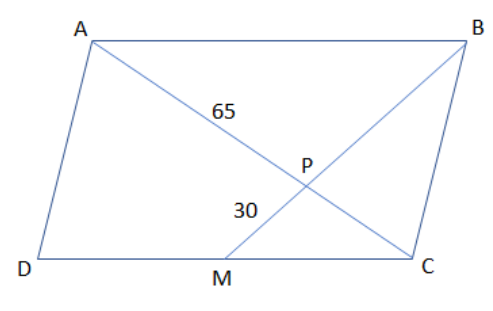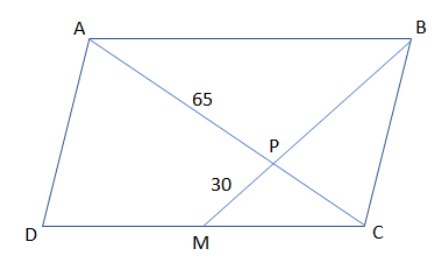
ABCD is a parallelogram M is the midpoint of DC. If AP=65 and PM=30, then the largest possible integer value of AB is

(a) 124
(b) 120
(c) 119
(d) 118

Answer
491.1k+ views
Hint: First, here we use the condition of the similarity of the triangles. Then, by using the condition of the similarity that the ratio of the sides of the similar triangles is always equal. Then, by using the condition that the sum of two sides of the triangle is always greater than the third side, we get the final result.
Complete step-by-step solution:
In this question, we are supposed to find the largest possible integral value of AB from the parallelogram ABCD drawn with conditions as:

Now, we have drawn the conditions from the question in the figure that PM=30 and AP=65.
Then, here we use the condition of that the triangles between the parallel lines AB and CD give the two triangles CMP and triangle ABP as similar by using the following property.
Now, we can also prove that by using the given figure with the condition that lines DC and AB are parallel in two triangle CMP and triangle ABP which gives:
So, by using the AAA property, we can conclude that
Now, by using the condition of the similarity that the ratio of the sides of the similar triangles is always equal.
So, by using the above-stated property and the condition is given in the question that M is the midpoint on DC, we get:
So, by using one of the ratios of the above condition, we know the value of the side PM=30.
Then, by using the ratio as:
Now, by substituting the value of PM=30 as:
Then, by using the condition that the sum of two sides of triangle is always greater than the third side.
So, by using the above-stated property for the triangle ABP as:
Now, by substituting the values of the AP and BP to get the maximum value of AB as:
So, it gives the condition that AB can have a value of less than
So, the largest value AB can have is
So, the largest value of side AB is
Hence, option (a) is correct.
Note: Now, to solve these types of the questions we need to know some of the basic properties of the triangle so that it will be easier for us to solve these types of problems. So, the properties required for these types of questions are: the sum of two sides of the triangle is always greater than the third side.
the condition of the similarity that the ratio of the sides of the similar triangles is always equal.
Complete step-by-step solution:
In this question, we are supposed to find the largest possible integral value of AB from the parallelogram ABCD drawn with conditions as:

Now, we have drawn the conditions from the question in the figure that PM=30 and AP=65.
Then, here we use the condition of that the triangles between the parallel lines AB and CD give the two triangles CMP and triangle ABP as similar by using the following property.
Now, we can also prove that by using the given figure with the condition that lines DC and AB are parallel in two triangle CMP and triangle ABP which gives:
So, by using the AAA property, we can conclude that
Now, by using the condition of the similarity that the ratio of the sides of the similar triangles is always equal.
So, by using the above-stated property and the condition is given in the question that M is the midpoint on DC, we get:
So, by using one of the ratios of the above condition, we know the value of the side PM=30.
Then, by using the ratio as:
Now, by substituting the value of PM=30 as:
Then, by using the condition that the sum of two sides of triangle is always greater than the third side.
So, by using the above-stated property for the triangle ABP as:
Now, by substituting the values of the AP and BP to get the maximum value of AB as:
So, it gives the condition that AB can have a value of less than
So, the largest value AB can have is
So, the largest value of side AB is
Hence, option (a) is correct.
Note: Now, to solve these types of the questions we need to know some of the basic properties of the triangle so that it will be easier for us to solve these types of problems. So, the properties required for these types of questions are: the sum of two sides of the triangle is always greater than the third side.
the condition of the similarity that the ratio of the sides of the similar triangles is always equal.
Recently Updated Pages
Master Class 9 General Knowledge: Engaging Questions & Answers for Success

Master Class 9 English: Engaging Questions & Answers for Success

Master Class 9 Science: Engaging Questions & Answers for Success

Master Class 9 Social Science: Engaging Questions & Answers for Success

Master Class 9 Maths: Engaging Questions & Answers for Success

Class 9 Question and Answer - Your Ultimate Solutions Guide

Trending doubts
Fill the blanks with the suitable prepositions 1 The class 9 english CBSE

Difference Between Plant Cell and Animal Cell

Given that HCF 306 657 9 find the LCM 306 657 class 9 maths CBSE

The highest mountain peak in India is A Kanchenjunga class 9 social science CBSE

What is the difference between Atleast and Atmost in class 9 maths CBSE

What was the capital of the king Kharavela of Kalinga class 9 social science CBSE




